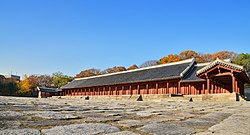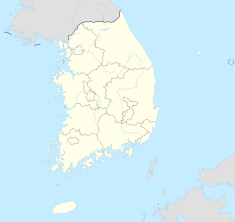
Back ضريح جونغميو Arabic Jongmyo (Seoul) BAN Jongmyo Catalan Čongmjo Czech Jongmyo German Santuario de Chongmyo Spanish جانگمیو Persian Jongmyo Finnish Sanctuaire de Jongmyo French જોન્ગમ્યો Gujarati
| Jongmyo Shrine | |
|---|---|
 Jeongjeon of Jongmyo Shrine | |
| Type | Confucian royal ancestral shrine |
| Location | 157 Jongno, Jongno District, Seoul, South Korea |
| Coordinates | 37°34′29″N 126°59′37″E / 37.57472°N 126.99361°E |
| Area | 200,545 m2 |
| Built | From 1394 |
| Governing body | Jongmyo Management Office, Cultural Heritage Administration |
| Owner | Government of South Korea |
| Website | english.cha.go.kr |
| Type | Cultural |
| Criteria | iv |
| Designated | 1995 (19th session) |
| Reference no. | 738 |
| Region | East Asia |
| Designated | 1963-01-18 |
| Reference no. | 125 |
| Korean name | |
| Hangul | 종묘 |
|---|---|
| Hanja | |
| Revised Romanization | Jongmyo |
| McCune–Reischauer | Chongmyo |
Jongmyo (Korean: 종묘) is a Confucian royal ancestral shrine in the Jongno District of Seoul, South Korea. It was originally built during the Joseon period (1392–1897) for memorial services for deceased kings and queens. According to UNESCO, the shrine is the oldest royal Confucian shrine preserved and the ritual ceremonies continue a tradition established in the 14th century. Such shrines existed during the Three Kingdoms of Korea period (57–668), but these have not survived. The Jongmyo Shrine was added to the UNESCO World Heritage list in 1995.[1]
Changdeok Palace and Changgyeong Palace lie to the north of Jongmyo. Yulgok-ro separated Jongmyo from the palaces from 1932 to 2019, until Yulgok-ro was turned into a road tunnel and the connection between Jongmyo and the palaces restored. The main buildings of Jongmyo were constructed in October 1394 when Taejo, founder and first king of Joseon, moved the capital to Hanseong (present-day Seoul). The shrine was destroyed by fire in the Japanese invasions of Korea (1592–1598), then rebuilt in early 1600s.
The shrine continues to be the venue for the Jongmyo Daejae ancestor-worship ceremony, where descendants of the imperial family honor the spirits of their deceased ancestors.
- ^ "Jongmyo Shrine". UNESCO World Heritage Centre. Retrieved 2021-03-10.

